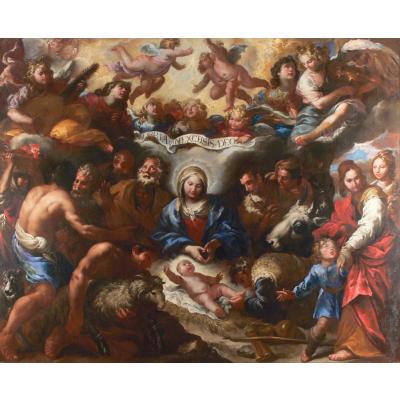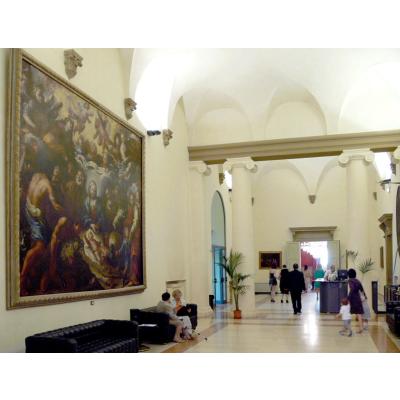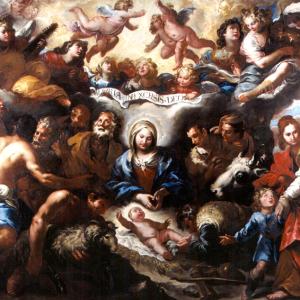Schede
Nunzio Rossi (1626 – 1651), Nativity, 1644. Size 470 x 420 cm ca. Signed below, center ‘NVTIO ROSSI F. 1644’. Bologna, Palazzo d’Accursio, the Mayor’s antechamber. From the church of San Girolamo della Certosa.
This is the first of a series of paintings commissioned by the Prior, Don Daniele Granchio. It is not surprising that such a relevant artwork was entrusted to a foreign painter and, what’s more, definitely very young - he was only 18 at the time. The various Italian Carthusian monasteries generally “exchanged” the artists who worked for them – in fact, Nunzio Rossi did work for the Neapolitan convent of the Carthusian Order before being commissioned with the works in Bologna. He was the only non-Bolognese artist included among the authors of the Christological cycle but his painting did not influence the local school, as his artistic language was quite far from the Bolognese painting modes. The warm colors, the vibrant figures taking up all available spaces, the very swift pictorial drafting, with little attention to anatomical accuracy were the exact opposite of the Classical perfection valued by the Bolognese painters who were entrusted with the other artworks. Nevertheless, such a peculiar choice on the part of the monks bequeathed to the city of Bologna a wonderful example of Neapolitan Baroque painting.
The restoration | This canvas was the worst-preserved of the whole Christological cycle. In the early 19th century it had been placed in an outer room of the convent and had suffered from dampness and considerable temperature changes. In 2004 Ottorino Nonfarmale was entrusted with the restoration but the painting was almost illegible and it was feared that most of the work could not be recovered. Given the serious damages caused by bad preservation, accurate diagnostic analyses were carried out and, on the basis of their results, a long painstaking restoration work began, which was to last over one year. The great efforts involved in consolidating the canvas, the subsequent cleaning and the careful integrations added to some of the missing parts brought Rossi’s masterpiece to light again and returned to the public an important artwork that the Bolognese had by now almost forgotten. Being it quite unfeasible to re-position the painting either in the same place as it hung in the 19th century, or in its original location inside the church, it is now hosted in one of the most valuable rooms inside the City Hall. Such a solution increased the public’s knowledge about the project for the recovery of the Certosa monumental complex to which the church, with its Christological cycle, belongs.
Nunzio Rossi (1626 – 1651) | Despite the recent studies and research devoted to him, this artist, a native of Naples, is still little known. Due to his quite untimely death and the fact that his paintings are scattered in various places, the number of his artworks that have been traced is extremely small. There is evidence that he was a student of Stanzione in his early teens; when he was seventeen he traveled to Bologna, where two of his works are documented, i.e. a painting to be placed above a fireplace in the Davia Bargellini Palace and a large canvas for the Certosa. As to the other works, mentioned in documents, that he produced for the Carthusian monastery, all track has been lost. Rossi traveled back to Naples between 1644 and 1646 and, heading south through the Calabria, reached Sicily where he painted several canvases for the local nobility. Very few of the artworks that have been ascertained as authored by him in this period remain, while most of the paintings mentioned in ancient documents are now lost or impossible to trace.







